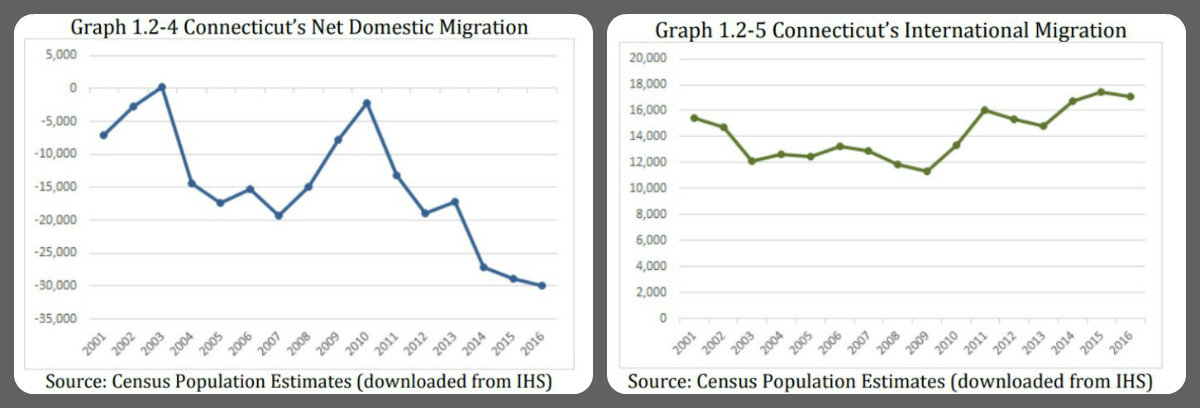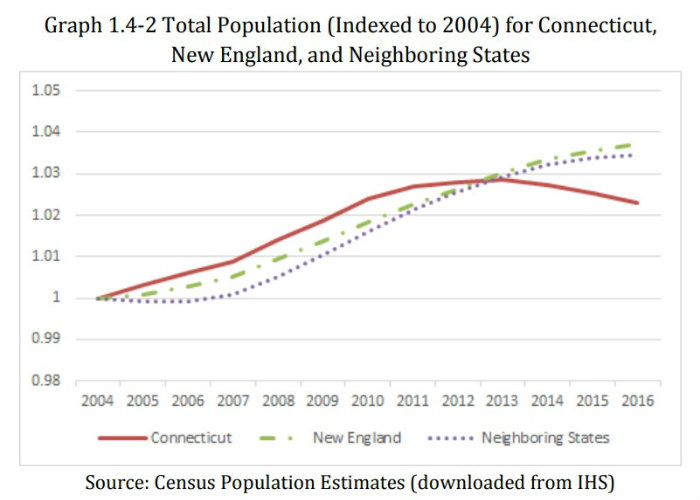Immigration Is the Only Thing Saving Connecticut From an Even Worse Budget Crisis
Residents are fleeing Connecticut at a rate of nearly 30,000 per year, but the state's ability to attract foreigners has cushioned the blow.
Connecticut's state motto—"Qui Transtulit Sustinet"—translates to "he who transplanted, sustains." It's a nod to the people who founded the Connecticut colony: immigrants who first fled religious persecution in England, then moved again out of disagreements with the ways their fellow colonists were running Massachusetts.
In the past few years, thousands of residents have transplanted themselves out of Connecticut. The state government has imposed two massive tax increases in the span of less than a decade. Those increases have not solved Connecticut's fiscal problems—the place finished the most recent fiscal year with a $3.5 billion deficit, and it's running in the red again this year—but they have certainly exacerbated the migration crisis.
The full fiscal crisis runs far deeper than the budget. Connecticut's debt has climbed from 12 percent in 1997 to 31 percent this year, according to the state Office of Fiscal Analysis. An analysis by The Connecticut Mirror found that annual debt service costs climbed by about 10 percent every year from 2011 to 2017. Equally unsustainable is the state's public pension system, which has a deficit of about $74 billion and only enough assets to meet 50 percent of its long-term obligations.
The biggest factor behind Connecticut's shrinking population, the state's Office of Policy Management noted in a report last year, is the sharp increase in the number of people leaving the state. Net out-migration was up 55 percent in the years 2014–16 when compared to the previous decade's averages. And it's not just individuals who are leaving: Companies—General Electric, Aetna, Alexion—have fled the state in search of a lower tax burden.
About the only thing that's working in Connecticut's favor right now is that it remains an attractive destination for international immigrants. While the state has been a net loser in domestic migration every year since 2003—with the biggest losses coming in 2014–2016—Connecticut has gained more than 10,000 residents from abroad every year this century. That won't solve the state's long-term financial problems, but it certainly could soften the blow.
Here's how that looks:

Connecticut is looking like the Illinois of New England: a place where tax increases are no longer fiscally or politically realistic, even though budgetary obligations continue to grow and spending is completely out of control. In fact, on a per capita level, Connecticut extracts more—about a thousand dollars more—from its residents than Illinois does, according to the U.S. Census Bureau.
While there are many reasons to leave Connecticut that have nothing to do with taxes—job opportunities, a better climate, getting away from New England Patriots fans—it's notable that the state's population decline sets it apart from its neighbors. Whether you compare it to the rest of New England or the rest of the states in the greater New York City region, Connecticut is an outlier:

Connecticut isn't just it's losing population. It's losing the high-earning (and therefore high-taxpaying) portion of its population. According to Internal Revenue Service data, the estimated 20,000 residents who left the state last year earned an estimated $2.6 billion in adjusted gross income. That about $130,000 per resident.
The decline started, as the chart above shows, after a $1.5 billion tax increase in 2011. Lawmakers followed that with a $1.2 billion tax increase in 2015, after which the exodus picked up steam. According to the Yankee Institute, a Hartford-based think tank, Connecticut has lost more than 77,000 people with a combined adjusted gross income of $8.8 billion since 2011.
"Connecticut has had a steady flow of people leaving the state for decades," says Suzanne Bates, director of public policy at the Yankee Institute. "But the pace has increased in recent years—and those years when the increase has been the greatest have been the years directly following large tax increases."
While immigration is helping to staunch the flow of people out of the state, Connecticut's loss of high-income residents is a serious problem because the state's tax code is so dependent on them. A recent study by the state Department of Revenue Services found that in 2014 just 357 families paid $682.5 million in state taxes—11.7 percent of the total haul.
Since the state government's strategy for dealing with ongoing fiscal shortages seems focused almost exclusively on raising taxes, it's probably just a matter of time before even more of those high earners look for refuge somewhere else.


Show Comments (115)